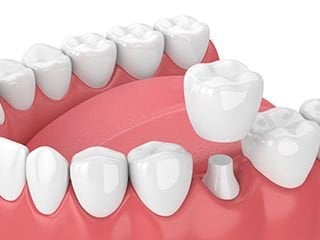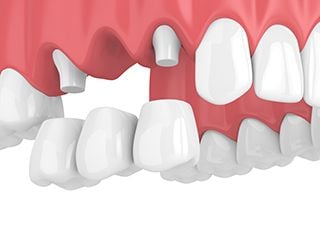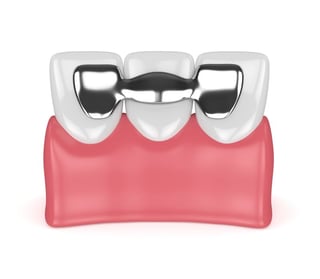Crowns and Bridges in Lubbock, TX

Decayed, broken, and missing teeth affect your oral health and your self-confidence. When a tooth has suffered structural or cosmetic damage, a dental crown from McNeill Dentistry here in Lubbock, TX can restore a tooth’s function and appearance.
What is a Dental Crown?
A crown is a custom-made “cap” that covers the entire visible surface of a tooth. Your Lubbock, TX dentist, Dr. Beau McNeill, might recommend a crown to:
- Strengthen and protect a tooth if extensive decay hasn’t left enough healthy tooth structure for a traditional filling
- Protect a cracked, broken, or brittle tooth from further damage
- Restore and reinforce a tooth after a root canal procedure
- Cover a deeply discolored or irregularly shaped tooth
- Complete a dental implant procedure
- Serve as an anchor for a dental bridge
What is Involved in Getting a Dental Crown?
Most crown placements require two appointments. During the first visit, tooth preparation includes reshaping the top and sides of the tooth so the crown fits comfortably. If too much healthy tooth structure has been lost, Dr. McNeill builds up the tooth with filling material so that it will support a crown securely.
An impression or a computer model is made of the prepared tooth, and a temporary crown, typically made of composite resin, is put in place to protect the tooth while the finished crown is fabricated at a dental lab. Every crown is custom designed to make sure it fits comfortably, aligns with the surrounding teeth, and doesn’t interfere with bite or jaw movement.
At a second visit, Dr. McNeill puts the finished crown in place and makes any needed adjustments to ensure that it fits properly before bonding it to the tooth. When the placement is ideal, the crown is secured in place using a special dental cement.
What are Crowns Made Of?
Crowns are made of several different materials. Your choice of crown can be based on factors such as durability, visibility, natural appearance, and cost:
- Metal crowns: Because they are alloys of gold, platinum, or other metals, these crowns are the longest lasting. They’re often chosen for back molars where they are less visible.
- All-porcelain/All-ceramic: These color-matched, translucent crowns are the most realistic looking option, especially for front teeth. They are also suitable for those with metal allergies.
- Porcelain fused to metal: These crowns have a porcelain layer applied over a metal core. Matched to your natural enamel color, these crowns look very realistic, although they’re not as translucent as all-porcelain crowns.
- Stainless steel: Typically used for baby teeth, pre-formed stainless steel crowns are a durable, cost-effective option when a crown is needed for a primary tooth.
- Composite resin: Made of color-matched resin, these crowns are a more affordable choice than porcelain or metal. Generally, however, they are only used as temporary crowns since they’re much less durable than other options.
Because a crown improves both the form and the function of a tooth, it is one of the most popular restorative treatments available.
What is a Dental Bridge?
A bridge is a restoration which will help you maintain your oral health while making your smile complete again.
Bridges use prosthetic teeth to “bridge” the gaps caused by missing teeth. These false teeth are known as pontics, and are crafted from metal, porcelain, or porcelain fused to metal. Pontics can be matched in size, shape, and color to the teeth they are replacing for a natural appearance. A bridge can replace up to four teeth but is typically used to replace one or two.
What are the Types of Bridges?
There are four common types of bridges, and the type of bridge which is best for you will depend on your preferences, your oral health, the location and number of missing teeth, cost, and other factors. Because a bridge requires healthy teeth, gums, and bone for a long-lasting and successful restoration, any dental problems will need to be treated beforehand.
Traditional Bridge

Traditional bridges are fixed in place and are anchored by crowns placed on the healthy teeth on each side of the gap. First, the two supporting teeth, known as abutment teeth, are prepared for crowns. This requires removing part of the tooth structure and creating an impression of each tooth. Crowns are created from these impressions and are attached on each side of the artificial tooth, creating the bridge. The crowns are then cemented to the prepared teeth, securing the entire bridge unit in place.
Cantilever Bridge

A cantilever bridge is used when there aren’t teeth available on both sides of the missing tooth to serve as abutment teeth. In this case, a healthy tooth on one side of the gap can be fitted with a crown to hold a single pontic. Because the pontic is only attached on one side, cantilever bridges aren’t recommended for the rear of the jaw, where chewing forces are much more powerful and the extra stress can damage the abutment tooth over time.
Maryland Bridge

A Maryland bridge is a more conservative treatment than a traditional bridge because there is no need for crowns to hold the bridge in place. A pontic is created with two wings made of resin, porcelain, or metal attached to its back. These wings are then bonded to the backs of the two abutment teeth. This type of fixed bridge is often used to replace one or two front teeth; it’s not strong enough to replace molars. Because no crowns are necessary, a Maryland bridge is generally more cost effective than other options.
Implant-Supported Bridge

An implant-supported bridge is a bridge attached to dental implants. Posts are surgically implanted in the jawbone, and, over a period of months, fuse with the bone, providing an exceptionally strong foundation for a bridge. The number of implants needed will depend on the location of the bridge (upper or lower jaw), the number of pontics, and the quantity and density of the bone.
Once the implant posts have healed and are well-integrated into the jawbone, metal or ceramic abutments are secured to the posts. The bridge is then secured to these abutments. The bridge can be fixed or removable for easier cleaning.
While this type of bridge is often the most expensive option, implant-supported bridges help protect jawbone health. Without the stimulation of biting and chewing, the bone ridge under a missing tooth begins to lose density and shrink. Implants stimulate bone tissue just as natural teeth do to preserve bone strength and density.
What are the Effects of Tooth Loss?
When you lose a tooth, it affects not just the appearance, but the function of your smile.
- It can be difficult to eat or speak naturally
- Extra stress is put on your remaining teeth
- You’re at greater risk for developing gum disease
- Your remaining teeth can shift out of position, causing bite problems
- The shape of your face and jaw can change over time
You have many options for replacing a lost tooth. Dr. Beau McNeill can help you determine which type of bridge is best suited to restore your healthy, confident smile.

